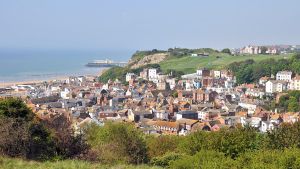
Saturday 22nd May - Hastings

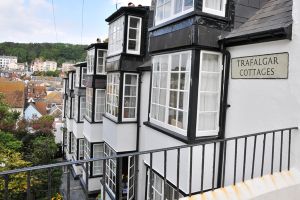
It's surprising where else in England you can find connections to Chitterne. I've just spent two days in Hastings in one of a row of six cottages named Trafalgar Cottages, supposedly built to house the widows of Naval Officers who died at the Battle of Trafalgar in 1805. Here in Chitterne the Round House supposedly commemorates that same battle. The cottages are in Old Town, Hastings, the original part, which in William the Conqueror's day had a good harbour. Not any longer; the harbour all but disappeared when 13th and 14th century storms altered the coastline. Today the town is a fishing and holiday centre with a famous line of tall black net-drying sheds at the landward edge of the shingle beach.
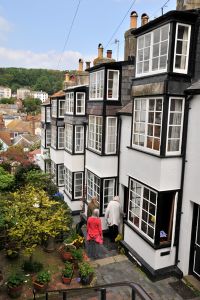
The cottage was very quaint, with tiny rooms on three floors connected by the narrowest stairs I have ever seen in a house. The cottages were built at right angles to the road, clinging to the side of the valley. We could reach the centre of Old Town in the bottom of the valley by negotiating a series of narrow stepped passageways between, and sometimes under, similar tightly-packed houses. From the hill above Trafalgar Cottages you could see right across Old Town, to the far side of the valley and the remains of King William's castle. An incredible vista of mis-matched dwellings, each house joined to the next but differing from it, in colour, size or roof material.
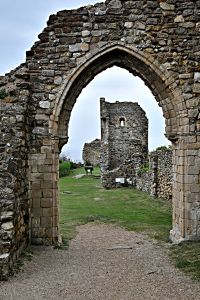
Hastings Castle is a ruin. Half of it has fallen into the sea or been pushed off the cliff by the 19th century entrepreneurs who caused Pelham Crescent to be built below. Except for the nearness to the sea, the castle has the same feeling about it as Old Sarum, which isn't surprising since they were contemporary. As with Old Sarum there was a motte and bailey castle at Hastings before the stone version. The Normans built many hundreds of castles in Britain all told, but Hastings was one of the first.
A very large group of students chattering away in French added an authentic atmosphere. Apparently they arrive in droves and study the castle and battle as part of their own history. All the descriptive plaques dotted about the site were in French and English. As the only two native English speakers present, except for the wardens, it was a bit deja vue. I was also reminded of Lacock Abbey where French was spoken until the dissolution, and its connection to our own village.
Sunday 16th May - William Titt's Wild Oats
After sterling work trawling through the Chitterne baptisms, JIR has put forward a theory that explains a conundrum concerning the many children attributed to William Titt in Chitterne around 1820-1840. JIR has identified William as the son of William Titt, the blacksmith, and Diane Cabel, who lived on the Green, Chitterne. He was born in Chitterne in 1805 and later became a master in the art of sowing wild oats.
The other characters in the drama are: Jane Carter born 1805; William's cousin Emma Feltham, nee Grant, born 1804; her husband John Alexander Feltham born 1803; and Mary Ann Andrews born 1807 at Knook, William's wife.
From a young age William had a relationship with Jane Carter which produced three children: Maria, Emma and Susanna. While Jane was pregnant with their last child Susanna, born 1832, William consorted with his cousin Emma Grant who it is assumed had by this time, been deserted by her husband, John Alexander Feltham, with whom she had one child, Mary Ann born 1824. Emma gave birth to William's child, another Susanna, in 1833. Both Susannas were born in Chitterne so Jane and Emma must have been aware of each other and that William was the father of their children, because William's relationship with Jane ended here. But were they aware that William had also been busy elsewhere?
Nearby, in the tiny, but aptly named, village of Knook, lived Mary Ann Andrews who gave birth to another of William's Children, Walter, in 1832 at Salisbury. This relationship stuck, the two married and Mary Ann went on to have nine more children. After the first three the couple moved to Maddington, and presumably William settled down.
Jane Carter, no longer with William, went on to have a fourth child, Isaac, with John Everley.
Emma Feltham died in 1836. Her daughter Susanna was brought up by grandparents John & Ann Grant. She was the great-great-great grandmother of JIR's wife.
Wednesday 5th May - New Play Equipment
The new play equipment purchased by the Parish Council with grant money has been installed in the sportsfield, and is already being well-used by the young of Chitterne. Some grown-up children have had a go too. Here are some pictures.

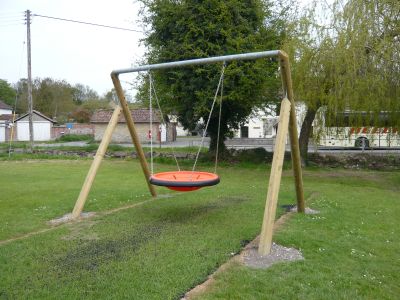
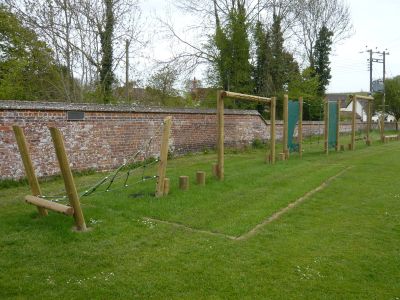
Today, I could hardly believe it but I heard that some villagers don't approve and think the equipment unsightly. What planet are they inhabiting?
Well chosen say I to the Parish Councillors. It looks good, does the job and is a great addition to the facilities in the sportsfield.